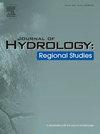Decomposition and attribution analysis of the coupled evolution characteristics of groundwater and land subsidence in the Beijing-Tianjin-Hebei Plain
IF 5
2区 地球科学
Q1 WATER RESOURCES
引用次数: 0
Abstract
Study region
This study investigated the relationship between groundwater storage and land subsidence and analyzed the potential causes of these variations in the Beijing-Tianjin-Hebei Plain from 2018 to 2022.
Study focus
Independent Component Analysis (ICA) was applied to separate signals from Interferometric Synthetic Aperture Radar (InSAR) surface deformation data and Gravity Recovery and Climate Experiment (GRACE) and GRACE-Follow On (GRACE-FO) groundwater storage anomalies. A spatiotemporal feature coupling analysis was then conducted on the periodic and trend components. The CNN-LSTM-attention neural network further quantified the drivers of groundwater changes in the trending subsidence area.
New hydrological insights for the region
(1) periodic components showed a strong positive correlation (cross-correlation coefficient = 0.73, with land subsidence lagging behind groundwater storage changes by 1 month) and a 5–6 month delayed response to precipitation, with high-score areas clustered in the precipitation-rich eastern and southern BTHP. (2) The trend components revealed synchronized declines (2018–2021), followed by rebounds, with groundwater recovery outpacing subsidence mitigation. High-score zones were aligned with regions of intense groundwater extraction (e.g., the southern BTHP). (3) In the trending subsidence area, CNN-LSTM-attention model achieved higher accuracy (test set R²: 0.54 vs −0.99, RMSE: 13.11 mm vs 43.12 mm) using reconstructed groundwater signals, confirming precipitation and anthropogenic extraction as significant contributing factors. This study provides a reference for exploring the relationship between changes in groundwater reserves and land subsidence.
京津冀平原地下水与地面沉降耦合演化特征分解与归因分析
研究区研究了京津冀平原区2018 - 2022年地下水蓄水量与地面沉降的关系,并分析了地表沉降变化的可能原因。应用独立分量分析(ICA)对干涉合成孔径雷达(InSAR)地表变形数据、重力恢复与气候实验(GRACE)和GRACE- follow On (GRACE- fo)地下水蓄水异常信号进行分离。然后对周期分量和趋势分量进行了时空特征耦合分析。CNN-LSTM-attention神经网络进一步量化了趋势塌陷区地下水变化的驱动因素。①周期分量对降水的响应具有较强的正相关(交叉相关系数= 0.73,地表沉降滞后于地下水蓄水量变化1个月)和5 ~ 6个月的延迟响应,高分区集中在降水丰富的东部和南部;(2)趋势分量呈现同步下降(2018-2021年)后反弹,地下水回收量大于沉降减缓量。高分区与地下水开采强度高的地区(如BTHP南部)对齐。(3)在趋势沉陷区,CNN-LSTM-attention模型利用重建的地下水信号获得了更高的精度(测试集R²:0.54 vs - 0.99, RMSE: 13.11 mm vs 43.12 mm),证实了降水和人为提取是显著的影响因素。该研究为探讨地下水储量变化与地面沉降的关系提供了参考。
本文章由计算机程序翻译,如有差异,请以英文原文为准。
求助全文
约1分钟内获得全文
求助全文
来源期刊

Journal of Hydrology-Regional Studies
Earth and Planetary Sciences-Earth and Planetary Sciences (miscellaneous)
CiteScore
6.70
自引率
8.50%
发文量
284
审稿时长
60 days
期刊介绍:
Journal of Hydrology: Regional Studies publishes original research papers enhancing the science of hydrology and aiming at region-specific problems, past and future conditions, analysis, review and solutions. The journal particularly welcomes research papers that deliver new insights into region-specific hydrological processes and responses to changing conditions, as well as contributions that incorporate interdisciplinarity and translational science.
 求助内容:
求助内容: 应助结果提醒方式:
应助结果提醒方式:


